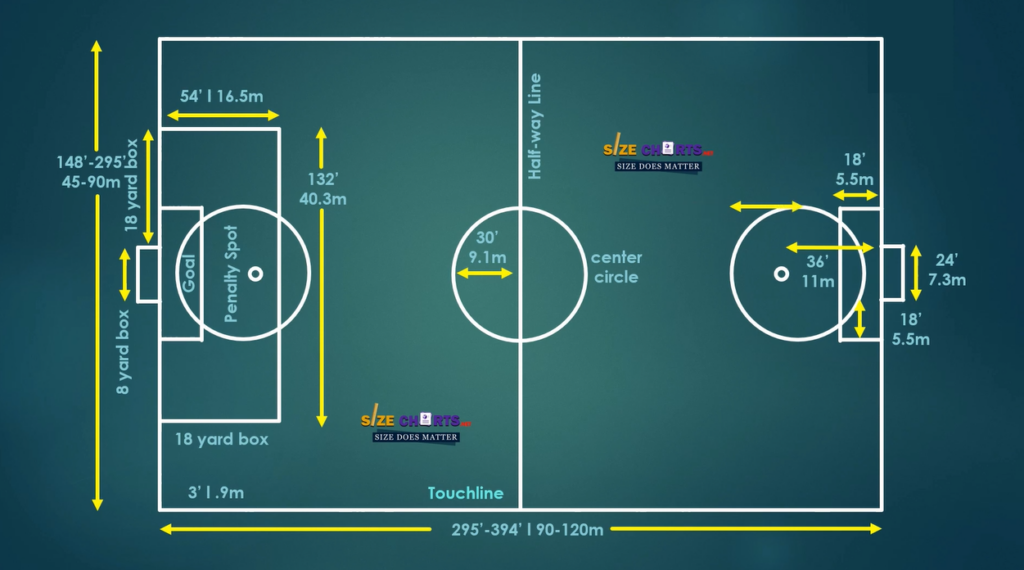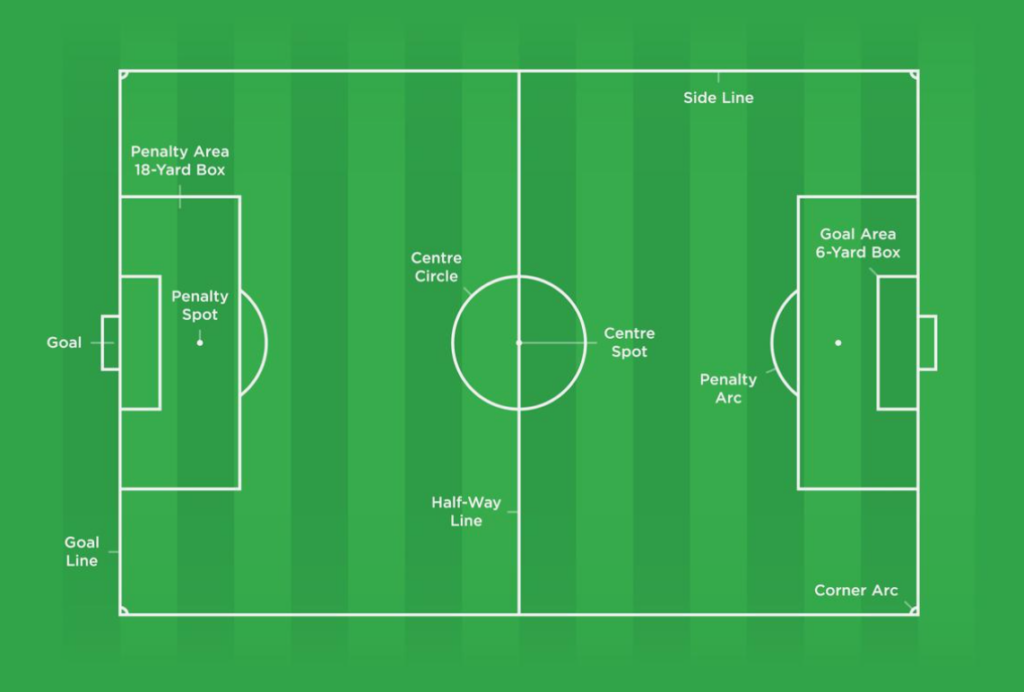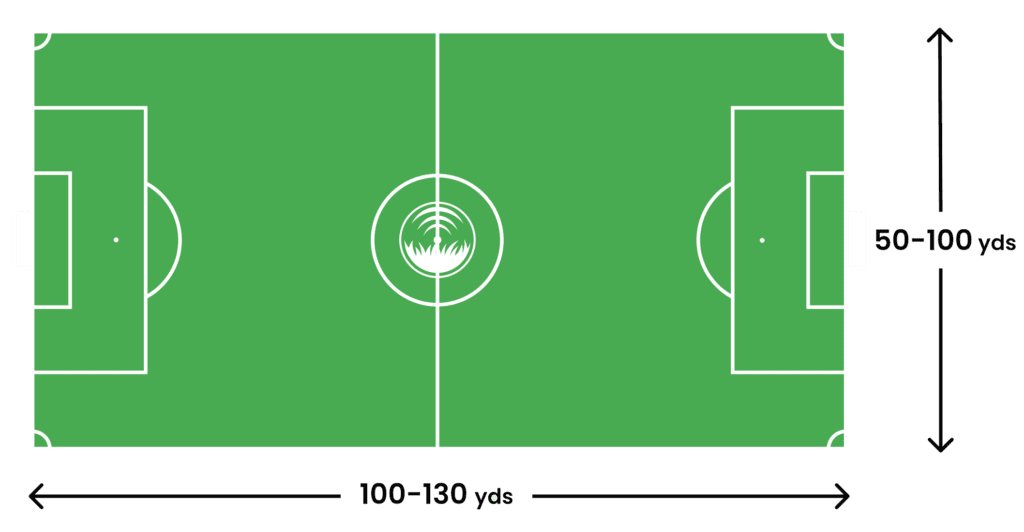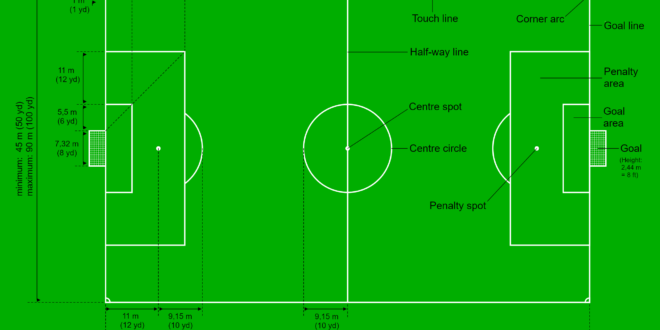A soccer field, also known as a football pitch, typically measures 100 to 130 yards long and 50 to 100 yards wide. These dimensions can vary based on the level of play and the governing body’s regulations.
Kicking off with the essential details for soccer enthusiasts and players alike, understanding the playing surface is crucial. Regulations set by FIFA, the sport’s global governing body, stipulate that international matches require a pitch size of 110–120 yards by 70–80 yards, ensuring a standard for top-level games.
Local and recreational fields might not adhere strictly to these measurements, giving some flexibility for space constraints and facility designs. These varying sizes nevertheless maintain the rectangular shape of the pitch, lined with distinctive markings that include a center circle, penalty areas, and corner arcs, integral to the flow and rules of the game. Acknowledging the dimensions forms the foundation of strategizing play and appreciating the game’s dynamics, whether as a player, coach, or fan.
🔴Soccer Field Dimensions🔴

Table of Contents
The Importance Of Regulation Soccer Fields
The Importance of Regulation Soccer fields cannot be overemphasized. Proper field dimensions play a crucial role in the game. They ensure fairness and provide a standardized playing field for all participants. This aspect of the sport touches on many facets, including the rules of play, equipment, and the overall integrity of the game.
Enhancing Fair Play
Ensuring fairness across all soccer matches is a top priority. When fields adhere to regulation dimensions, all players have an equal opportunity to showcase their skills. This creates a level playing field where only talent and teamwork dictate the outcome.
- A minimum length of 100 yards (90 meters) and a maximum length of 130 yards (120 meters).
- A minimum width of 50 yards (45 meters) and a maximum width of 100 yards (90 meters).
International Standards
The International Soccer Federation mandates field dimension regulations. This unification helps maintain the game’s global integrity and ensures all players are judged by the same criteria.
| Component | Regulation Size |
|---|---|
| Field Length | 100 – 130 yards (90 – 120 meters) |
| Field Width | 50 – 100 yards (45 – 90 meters) |
| Goal Area | 6 yards (5.5 meters) from each goal post |
| Penalty Area | 18 yards (16.5 meters) from each goal post |
All official matches are played on fields that match these specifications. Players can trust that their efforts in training can be effectively applied in competition.
Soccer Field Size Basics
Understanding soccer field size basics is crucial for players, coaches, and fans alike. The dimensions of the pitch play a pivotal role in the game’s flow and the strategies employed by teams. Knowing the size parameters helps in appreciating the physical demands of the sport and how space is used in various tactics. Let’s dive into the specifics, starting with the minimum and maximum dimensions outlined by the sport’s governing bodies.
Minimum And Maximum Dimensions
The size of a soccer field, also known as a pitch, varies within preset limits. The governing body for soccer, FIFA, stipulates acceptable ranges for both length and width. The following details ensure a pitch meets official standards:
| Pitch Part | Minimum Size (meters) | Maximum Size (meters) |
|---|---|---|
| Length | 90 | 120 |
| Width | 45 | 90 |
Comparison To Other Sports Fields
Soccer pitches can appear quite vast, especially when compared to fields of other popular sports. Below is a comparison showing how soccer fields stack up against other sports fields:
- Football: A soccer field is wider but can be about the same length as an American football field.
- Baseball: Soccer fields offer more continuous space, unlike the shape-restricted diamond of a baseball field.
- Basketball: A standard soccer field is significantly larger than a basketball court.
- Rugby: Rugby pitches share similar dimensions but are typically narrower and shorter than soccer fields.
- Tennis: A soccer field can encompass multiple tennis courts, given its extensive size.
Anatomy Of A Soccer Field
The soccer field, or pitch, is more than just grass and lines. Each marking has a purpose, guiding play and keeping order during the fast-paced game. To truly understand the sport, one must know the field’s layout.
Pitch Markings
Pitch markings are critical to a soccer game. They outline the boundaries and zones for players, referees, and fans. Key lines include the halfway line, which divides the field, and the penalty and goal areas, signaling where key game actions occur. Using bold white paint, these lines stand out against the green.
- Touchlines: The longest sides of the field
- Goal lines: The shorter sides where goals are
- Center circle: Shows kick-off spot
- Penalty spots: Where penalty kicks occur
| Feature | Description |
|---|---|
| Corner Arc | Small quarter-circles for corner kicks |
| Penalty Area | Large box for goalkeeper handling and penalties |
The field’s dimensions are standardized for professional games but can vary for smaller leagues. Players, coaches, and referees all depend on these markings to play the game according to the rules.
The Goal Area Explained
The goal area, often called the six-yard box, is critical in soccer. It marks where a goalkeeper can handle the ball and where goal kicks are taken from. Understanding this area is vital for defending and scoring strategies.
- Close to the goal line
- Rectangular in shape
- Extends six yards into the pitch
Attackers aim to breach this area for scoring opportunities. Conversely, defenders work hard to clear the ball from this zone. A deep understanding of the goal area leads to mastering offensive and defensive play.

Variations Across Leagues And Age Groups
The space where the beautiful game unfolds varies by league and age. Soccer fields don’t have a one-size-fits-all standard. Across the globe, field dimensions change to accommodate different levels of play. Whether you’re watching youth matches or cheering at a professional stadium, the size of the pitch can add a unique twist to the game.
Youth Soccer Adjustments
Soccer fields for children adjust to their needs. Young players need smaller fields. It’s all about safe play and fun. Here’s how field sizes vary for different age groups:
- U-6: 15-20 yd x 25-35 yd
- U-8: 20–25 yd. x 30–40 yd
- U-10: 30-40 yd x 50-60 yd
- U-12: 40-55 yd. x 60-75 yd
Younger players enjoy and learn soccer without running too much. The smaller fields make this possible.
Professional Vs. amateur Fields
Big league fields are bigger than amateur ones. This is due to rules set by FIFA and other organizations.
| Level | Length | Width |
|---|---|---|
| Professional | 100-130 yd | 50-100 yd |
| Amateur | 90-120 yd | 45-90 yd |
Pros need larger fields for their advanced skills and fitness. Amateur fields cater to local community needs and space availability.
The Goal Dimensions
Understanding goal dimensions is crucial in soccer. The precise measurements influence the dynamics of the game. Each element of the goal structure has specific dimensions important for players, coaches, and enthusiasts to grasp. Below, we delve into the nitty-gritty of crossbar and post measurements, followed by the details of net size and shape.
Crossbar And Post Measurements
The crossbar and posts frame the goalmouth, defining the target area for scoring. These components must adhere to official regulations to ensure fair gameplay.
- Width between the posts: 7.32 meters (8 yards)
- Height from ground to crossbar: 2.44 meters (8 feet)
- Post and crossbar width: not exceeding 12 centimeters (5 inches)
The crossbar connects the posts, creating a square or rectangular goal that players aim for.
Net Size And Shape
The net catches the ball after a successful goal. It is an essential part of the soccer goal dimensions.
- Nets attach to the posts, crossbar, and ground behind the goal.
- Designed to avoid interfering with the goalkeeper, nets slope backward.
- It is usually made of hemp, jute, or nylon with a mesh size not exceeding 15 centimeters (6 inches).
Ensuring nets are properly secured and checked before a game helps maintain the uninterrupted flow of the match.
The Penalty Area And Its Importance
The penalty area, also known as the “18-yard box,” is crucial in soccer. It is a key zone where defensive errors can lead to penalty kicks. This area dictates many strategies for both attackers and defenders. Goals often result from the actions within this rectangle.
Penalty Spot And Arc
At the heart of the penalty area lies the penalty spot. This spot is 12 yards from the goal line. A player takes a penalty kick from here. It’s a high-stakes moment in any match. The semi-circle at the edge of the area is the penalty arc. This arc ensures players stay 10 yards back during a penalty kick.
The Role In Game Dynamics
The penalty area changes game dynamics significantly. For attackers, breaching this box raises their chances of scoring. For defenders, it’s crucial to clear the ball carefully. Fouls here can cost a goal. Every move in this zone can shift the game’s flow, making it both revered and feared.
| Feature | Dimension |
|---|---|
| Penalty Area | 44 yards wide and 18 yards deep |
| Penalty Spot | 12 yards from the goal line |
| Penalty Arc | 10 yards from penalty spot |
- Defenders avoid fouls in the penalty area.
- Attackers aim to draw fouls here.
- Referees watch this area closely.
Corner Arcs And Their Purpose
The corner arcs on a soccer field may seem minor, but they hold significant importance. Positioned at the four corners of the field, these quarter-circle arcs each have a radius of 1 yard. They mark the spot from where corner kicks are taken, influencing both the rules of the game and the strategies employed by teams.
Corner Kick Regulations
The regulations surrounding corner kicks are essential for fair play. Here are the main points:
- The ball must be placed within the corner arc.
- Opponents must stay at least 10 yards away until the ball is in play.
- The kicker cannot touch the ball twice consecutively.
Impact On Strategy
Teams utilize corner arcs to create scoring opportunities. Here’s how:
- Players may use the arc’s curve to bend the ball towards the goal.
- Teams develop specialized set plays to exploit these chances.
- Effective use of the corner arc can change the game’s momentum.

Maintaining Soccer Field Dimensions
Playing soccer on a field that meets precise dimensions is crucial. Accurate soccer field dimensions ensure fairness and uniformity in the game. Teams and referees rely on a well-maintained pitch for optimal play. This section covers the essential steps and checks for maintaining the official size and markings of a soccer field.
Groundskeeping Best Practices
Expert groundskeepers follow these steps to maintain perfect soccer fields:
- Regular Mowing: Keep grass height uniform and optimal for play.
- Marking Lines: Use durable paint for clear, visible lines.
- Sod Management: Repair patches to prevent uneven surfaces.
- Irrigation: Ensure consistent watering for healthy turf.
- Drainage: Install systems to avoid water accumulation.
Regular Checks And Adjustments
Routine inspections are vital. They include:
- Verifying field dimensions against official guidelines.
- Checking goalpost integrity and net security.
- Assessing turf health for signs of wear or disease.
- Updating any faded boundary lines promptly.
- Ensuring corner flags are correctly positioned.
Soccer Field Markings
Understanding soccer field markings is key to appreciating the beautiful game.
The pitch is more than just grass; it’s a canvas with precise lines guiding play.
Line Thickness And Material
The rules of soccer dictate specific standards for line thickness and material.
- Lines should measure between 4 inches (10 cm) to 5 inches (12 cm) in width.
- The material used for lines is typically a durable, white paint to contrast with the green field.
Visibility And Maintenance
Proper visibility of field markings is essential for both players and officials.
- Regular maintenance ensures lines remain visible throughout the game.
- Routine inspections, touch-ups, and repainting are necessary for optimal playability.

Impact Of Field Dimensions On Play Style
Understanding how field dimensions affect play style is crucial in soccer. The size of the pitch can change how teams approach the game. Coaches and players alike must adapt their strategies to either a larger or smaller field. This adaptability can be the difference between a win or a loss.
Tactics On Larger Vs. Smaller Pitches
On a larger pitch, teams have more space to maneuver. This allows them to spread out the play and exploit wide areas. In contrast, smaller pitches often result in a tighter, more congested playing area. Here are the main differences:
- More passing lanes open on larger fields
- Speedy wingers thrive with extra space
- Compact defense is easier on smaller pitches
- Quick interchanges are more common in tight spaces
A team’s skill set can shine or falter depending on the pitch size. Direct play might succeed on smaller fields. In contrast, a possession-based game might flourish on a larger one.
Adapting To Field Conditions
Each soccer field presents unique conditions. Teams must modify their approach accordingly. Here are key adjustments:
- Grass length and moisture can slow down or speed up the ball.
- Weather conditions influence the playing surface.
- Prioritize stamina and fitness for larger fields.
| Field Size | Tactical Adjustment |
|---|---|
| Large | Utilize width, control possession |
| Small | Emphasize defense, play quicker |
Mastering the art of adapting to different field sizes is essential. A team’s ability to adjust can define their style and success on the field.
Frequently Asked Questions On Soccer Field Dimensions
How big is a professional soccer field?
A professional soccer field, according to FIFA standards, measures between 100-110 meters in length and 64-75 meters in width. This ensures enough space for high-level play.
Are youth soccer fields smaller in size?
Yes, youth soccer fields are smaller to accommodate the physical capabilities of younger players. Dimensions vary based on age groups but are generally scaled down in size.
What is the size of a high school soccer field?
High school soccer fields typically measure between 91 and 110 meters in length, and 55 to 73 meters in width. These dimensions are slightly smaller than professional fields.
How wide are soccer field goalposts?
Soccer field goalposts are 7. 32 meters wide, which is the standard width worldwide for both professional and amateur play, facilitating uniformity in the game.
Conclusion
Understanding the precise measurements of a soccer field is fundamental for players, coaches, and fans alike. Whether you’re setting up a local game or planning a professional event, knowing these dimensions ensures a standardized, fair playing ground. So, lace up your cleats and head to the pitch equipped with the knowledge necessary for a true soccer experience.
 SMGB TODAY Sports, Movies, TV Shows
SMGB TODAY Sports, Movies, TV Shows

